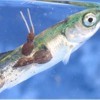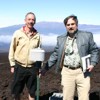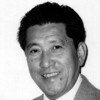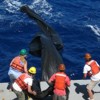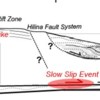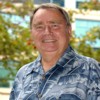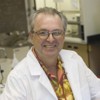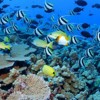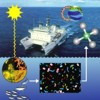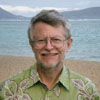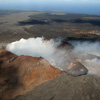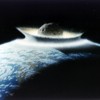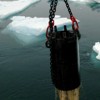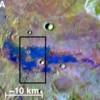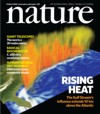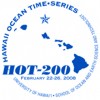SOEST Press Releases: 2008 Archive
|
December 11: Ocean fish farming harms wild fish, study saysFarming of fish in ocean cages is fundamentally harmful to wild fish, according to an essay in this week’s Conservation Biology. Using basic physics, Professor Neil Frazer of the Department of Geology and Geophysics at the University of Hawaii at Manoa explains how farm fish cause nearby wild fish to decline. The foundation of his paper is that higher density of fish promotes infection, and infection lowers the fitness of the fish. For wild fish, lowered fitness means more difficulty finding food and escaping predators, causing higher death rates. But farmed fish are not only fed, they are also protected from predators by their cage, so infected farm fish live on, shedding pathogen into the water. The higher levels of pathogen in the water cause the death rates of wild fish to rise. Read the press release. Image credit: Alexandra Morton, Raincoast Research. |
|
December 2: Understanding the Daily Variation in Atmospheric PressureFor over two centuries, meteorologists were puzzled by the
observation that atmospheric pressure in the tropics peaks at 10 am
and 10 pm nearly every day. In the late 1960s, a theory was proposed
that these surface pressure variations result from waves that are
generated by the sun's heating of the upper atmosphere. The waves,
called solar tides, propagate to the ground as they travel around the
globe. Strong support for this theory has now been presented in a Image credit: IPRC/SOEST |
|
November 5: UHM Marine Biologist Elected President-Elect of the Acoustical Society of AmericaWhitlow W. L. Au, Chief Scientist in the Marine Mammal Research Program at the Hawaii Institute of Marine Biology, University of Hawaii at Manoa, has been elected President-Elect of the Acoustical Society of America (ASA) which is headquartered in Melville, NY. He began his one-year term in July 2008, after which he will succeed the current President. “The Acoustical Society of America is a splendid professional organization. Nearly all the world’s top acousticians are members. We count physiologists, psychologists, physicists, engineers, biologists, health care specialists, sound engineers, and others among our members,” Au said. “It is an honor and a pleasure to belong to this society and an even a greater and humbling honor to be elected to serve as its president.” Read the press release. Image credit: Au/SOEST |
|
September 18: UHM Professor G. Jeffrey Taylor to Receive Carl Sagan MedalG. Jeffrey Taylor, Planetary Scientist at the Hawaii Institute of Geophysics and Planetology (HIGP) in the School of Ocean and Earth Science and Technology at the University of Hawaii at Manoa, has been named the 2008 recipient of the Carl Sagan Medal for Excellence in Public Communication in Planetary Science. The prize is named after Carl Sagan (1934-1996), a distinguished planetary scientist who, through public lectures, television, and books, contributed significantly to the public's understanding of planetary science. The Sagan Medal is awarded by the Division for Planetary Sciences (DPS) of the American Astronomical Society to recognize and honor outstanding contributions by active planetary scientists to the public's understanding of, and enthusiasm for, planetary science. Taylor is the ninth recipient of the Sagan Medal and the first from the University of Hawaii. Read the press release. Image credit: HIGP/SOEST |
|
September 4: Complex ocean behavior studied with 'artificial upwelling'HOT and C-MORE oceanographers led by Dave Karl and Ricardo Letelier were highlighted in the new Discovery Channel series called Discovery Project Earth. The “Hungry Oceans” episode showed how researchers are looking at wave-powered ocean pumps that could increase ocean productivity and decrease carbon dioxide in the atmosphere. The show premiered on Friday, September 5, 2008, at 7 pm HST on the Discovery Channel, with a rebroadcast the following Sunday morning. Read more about it in the Honolulu Star-Bulletin, the SOEST Press Release (PDF), at EurekAlert, and at UPI.com. Image courtesy of the Dave Karl, et al.; click on it to see the full version. |
|
August 28: Magmatically Triggered Slow Earthquake Discovered at Kilauea Volcano, HawaiiFrom June 17-19th 2007, Kilauea experienced a new dike intrusion, where magma rapidly moved from a storage reservoir beneath the summit into the east rift zone and extended the rift zone by as much as 1 meter. Researchers from the University of Hawaii at Manoa (UHM), Scripps Institution of Oceanography at UC San Diego, and the U.S. Geological Survey (USGS) Hawaiian Volcano Observatory have now discovered that the 2007 dike intrusion was not the only action going on: the dike also triggered a "slow earthquake" on Kilauea's south flank, demonstrating how magmatism and earthquake faulting at Kilauea can be tightly connected. The research findings will be published in the Friday, August 29th edition of the prestigious journal Science. Read the press release. Image credit: James Foster, HIGP/SOEST |
|
August 22: Klaus Keil Reappointed to Space Studies BoardHIGP Professor and renowned planetary scientist Klaus Keil has had his appointment to serve on the Space Studies Board of the National Academy of Sciences (NAS) renewed until 2010. Keil is one of 23 members chosen from across the United States that currently serve on the Space Studies Board. Read more about it in the Honolulu Advertiser and the Honolulu Star Bulletin, or read the Press Release. Image credit: SOEST |
|
July 22: UH Manoa Oceanographer receives $3.79 million grant from Gordon and Betty Moore FoundationUniversity of Hawai‘i at Mānoa Professor David Karl has been named the recipient of a $3.79 million grant from the Gordon and Betty Moore Foundation to continue and expand research on the microbial inhabitants of the world’s oceans. Dr. Karl, founder of the Center for Microbial Oceanography: Research and Education (CMORE) in SOEST, has focused his research on the ecological role of microorganisms in the oceans, ranging from the sunlit surface waters to the deep abyss. Dr. Karl has led groundbreaking efforts to promote collaborations among the previously separate disciplines of oceanography, microbiology, ecology and genomics to better understand the sea, including its potential response to environmental variability and climate change. Read the press release. Image credit: University of Hawaii |
|
July 17: New Indicator Uncovered that can Predict Coral HealthA new indicator of coral health has been discovered in a community of microscopic single-celled algae called dinoflagellates. The study, released in the July 8th edition of the journal Proceedings of the National Academy of Sciences, reveals that a particular type of these algae renders corals more susceptible to disease. “Corals are fascinating organisms whose survival is dependent on dinoflagellates that live inside the coral’s tissue,” says lead author Michael Stat, an assistant researcher at the Hawaii Institute for Marine Biology (HIMB) at the University of Hawaii at Manoa. “The relationship between these dinoflagellates and corals has long been considered mutually beneficial, with the dinoflagellates supplying the coral with food via photosynthesis in return for recycled nutrients and shelter. Over the last 20 years it has been made clear that there are many different types of dinoflagellates in corals and that the unions or symbiosis between a given coral and their dinoflagellates can be very specific.” It had previously been considered that all dinoflagellates found in coral are equally beneficial to their coral host, but in this study Stat, along with HIMB researchers Ruth Gates and Emily Morris, present evidence that a particular type of dinoflagellate can be found in corals that are diseased or show evidence of having had a disease. Read more about it. Image credit: Michael Stat, HIMB/SOEST/UH |
|
July 3: Halting Ocean Acidification Calls for Steep Carbon CutsIt’s not just about climate change anymore. Besides loading the atmosphere with heat-trapping greenhouse gases, human emissions of carbon dioxide have also begun to alter the chemistry of the ocean—the so-called cradle of life on Earth. Image credit: James Watt, www.wattstock.com |
|
July 2: New Pathway for Methane Production in the OceansA new pathway for methane production has been uncovered in the oceans, and this has a significant potential impact for the study of greenhouse gas production on our planet. The article, released in the prestigious journal Nature Geoscience, reveals that aerobic decomposition of an organic, phosphorus-containing compound, methylphosphonate, may be responsible for the supersaturation of methane in ocean surface waters. Oceanographer David Karl was interested in this “methane enigma” and why the surface ocean was loaded with methane, over and above levels found in the atmosphere. When looking at the literature, Karl found a possible solution to the enigma, in the compound methylphosphonates, a very unusual organic compound only discovered in the 1960s. In the laboratory, the aerobic growth of certain bacteria on methylphosphonate can lead to the production of methane, but until now this process of methylphosphonate degradation in the ocean had not been suggested as a possible pathway for the aerobic production of methane in the sea. Read more about it. Image credit: C-MORE/ SOEST |
|
June 25: Award-winning publication donated to more than 100 schools statewideIn order to perpetuate greater environmental literacy throughout the State and to celebrate the International Year of the Reef, the University of Hawai‘i Sea Grant College Program (UH Sea Grant) has donated over 100 copies of its recently published Reef and Shore Fishes of the Hawaiian Islands to secondary school libraries statewide. Recognizing that there is an urgent need to increase awareness and understanding of coral reefs, 2008 was designated as the International Year of the Reef. By donating copies of Reef and Shore Fishes of the Hawaiian Islands to every public and private school throughout the State and through other successful environmental literacy and marine education programs, UH Sea Grant hopes to increase awareness and inspire future generations of marine scientists and professionals. Read more about it. Image credit: Hawaii Sea Grant / SOEST |
|
June 17: Edward Scott awarded Leonard Medal by Meteoritical SocietyPlanetary scientist Edward Scott has been awarded the 2008 Leonard Medal by the Meteoritical Society, an honor which recognizes outstanding contributions to the science of meteoritics and closely allied fields. Scott, a professor in the Hawaii Institute of Geophysics and Planetology (HIGP) within the School of Ocean and Earth Science and Technology at the University of Hawaii at Manoa, studies meteorites, planetary science, and cosmochemistry. The Meteoritical Society is an international organization founded in 1933 to promote the study of extraterrestrial materials and planetary science. The Leonard Medal was established in 1962 and is named after Frederick C. Leonard, the first President of the Society. Read more about it. Image credit: Scott/ SOEST |
|
May 29: NOAA Announces Funding to Support Ocean Observing in Hawaii
|
|
May 22: Free Homeowner’s Handbook Now AvailableMay 18th marked the beginning of hurricane awareness week in Hawai‘i. This is the time to gather information on protecting your family and property from a hurricane before such a storm strikes our shores. This is also the time to take those critical, potentially life-saving steps toward safeguarding your home in the event of a devastating storm. The Homeowner’s Handbook to Prepare for Natural Hazards, published by the University of Hawai‘i Sea Grant College Program, provides detailed information on how to prepare your home for a hurricane and other natural hazards including earthquakes, tsunamis, and floods. Protecting your home often means protecting your family. The handbook outlines small and cost-effective steps that can significantly reduce the risks of damage and loss due to a natural hazard. Read more about it from the Sea Grant Press Release. Image credit: Hawaii Sea Grant / SOEST |
|
April 28: Climate cycle “entirely out of equilibrium”Before humans began burning fossil fuels, there was an eons-long balance between natural carbon dioxide emissions (eg. from volcanoes) and Earth’s ability to absorb them, but now the planet can’t keep up. “These feedbacks operate so slowly that they will not help us in terms of climate change… that we’re going to see in the next several hundred years,” said Oceanography Dept. assistant professor Richard Zeebe, one of the authors of a study published in the journal Nature Geoscience. “Right now we have put the system entirely out of equilibrium.” Read more about it from the UH Press Release. Image credit: USGS |
|
April 16: Karl to deliver 20th Annual C. B. Van Niel Memorial LectureDavid M. Karl, Professor of Oceanography and Director of the Center for Microbial Oceanography: Research and Education (C-MORE) has been invited to deliver this year’s Van Niel Memorial Lecture. The presentation, “Microbial Oceanography: A Sea of Opportunity” will be given at Stanford University’s Hopkins Marine Station in Pacific Grove, California on April 18th, 2008. This is the 20th annual lecture in the series, established shortly after the death of Cornelius Bernardus Van Niel, perhaps the most influential microbiologist and educator in the 20th century. Previous speakers in this lecture series have included two Nobel laureates and many other distinguished scientists. Read more about it. Image credit: Karl / SOEST |
|
April 10: New Strategy for Determining Chondritic Meteorite Impact SizesScientists have developed a new tool for determining the projectile size and frequency of chondritic meteorites that have collided with the Earth. François Paquay, a Doctoral graduate student in the Department of Geology and Geophysics at the University of Hawaii at Manoa (UHM) used variations of osmium isotope composition in the marine sediment record to estimate size of these impactors, the results of which are published in the April 11th edition of the prestigious journal Science. Read more about it. Image credit: Don Davis/NASA |
|
March 28: Ancient Heterogeneous Mantle Found Below Arctic OceanScientists have discovered highly heterogeneous mantle rocks beneath the Gakkel Ridge in the Arctic Ocean. These rocks have survived the mixing process in the deep mantle and some have retained their two billion year old melting signatures, preserved by the complex geologic history of the region. The unprecedented discovery of these rocks indicates that mantle heterogeneity may turn out to be more widespread in mid-ocean ridge settings than inferred from the more commonly studied erupted lavas. The results are published in the March 20th edition of the prestigious journal Nature. Read more about it. Image credit: Heinz Feldmann, Max-Planck Institute for Chemistry, Mainz, Germany |
|
March 20: Salty Spots on Mars Suggest Where to Look for Life's Ancient TracesScientists using a camera on NASA's Mars Odyssey orbiter have found the first evidence for deposits of chloride salts in numerous places on Mars. The salt deposits point to places where water was once abundant and where evidence of former Martian life may exist, say the researchers. A team led by graduate student Mikki Osterloo, of the Hawaii Institute for Geophysics and Planetology, found about 200 places within the southern highlands of Mars that show spectral characteristics consistent with chloride minerals. Read more about it. Image credit: Mikki Osterloo / THEMIS operated by NASA/JPL/Arizona State University |
|
March 12:Gulf Stream Leaves its Signature 7 Miles High!The Gulf Stream anchors a precipitation with upward motions and cloud formations that can reach 7 miles high. The study, of which the International Pacific Research Center's Shang-Ping Xie is co-author, is published as the cover article in the March 13 issue of Nature. Read more about it. Image credit: Nature |
|
Feb 25: UH Ocean Research Program Reaches MilestoneOn February 21, 2008, the UH research vessel Kilo Moana departed from the UH Marine Expeditionary Center at pier 45 on the 200th scientific expedition of HOT after nearly 20 years of approximately monthly research cruises to observe and interpret habitat variability and to track climate impacts on Hawaii’s marine ecosystem. Read more about it. Image credit: HOT / SOEST |
|
Feb 9: Punahou School wins Hawaii Ocean Science BowlThis past Saturday, February 9th, high school students from all over the state competed in the sixth annual Hawaii Regional competition for the National Ocean Science Bowl (NOSB), the “Aloha Bowl”. Five high school students from Punahou School won the competition, and will represent Hawaii in the National Ocean Science Bowl in Seward, AK April 25-27, 2008. Members of the winning team include (from left to right in picture) Thomas Young, Randy Wong, Allison Chen, Rentaro Matsukata, Eric Liaw, and Coach David Strang Kealakehe High School took second place, with Iolani School coming in third. Read more about it. Image credit: Hawaii Ocean Science Bowl / SOEST |
|
Jan 11: UH Researcher will be watching closely as MESSENGER Spacecraft makes close flyby of MercuryDr. Jeffrey Gillis-Davis, an assistant researcher in the Hawaii Institute of Geophysics and Planetology (HIGP), is a team member on the MESSENGER space mission, a spacecraft which will make a close flyby of the planet Mercury on Monday, January 14th. MESSENGER is an acronym that stands for MErcury Surface, Space ENvironment, GEochemistry, and Ranging, it will be the first spacecraft to visit Mercury in thirty-three years. The pictures and data acquired this Monday will mostly cover an area of Mercury that has never been photographed before. Read more about it. Image credit: NASA/Johns Hopkins University Applied Physics Laboratory/Carnegie Institution of Washington
|
News archives: 2015 • 2014 • 2013 • 2012 • 2011 • 2010 • 2009 • 2008 • 2007 • 2006 • 2005 • 2004 • 2003 • 2002Press release archives: 2015 • 2014 • 2012 • 2012 • 2011 • 2010 • 2009 • 2008 • 2007 • 2006 • 2005 • 2004 and earlierIf you have news to share, or would like more information about any of the above, please contact:
Mahalo! (Thank you!)
|
|

